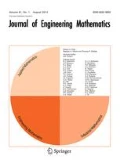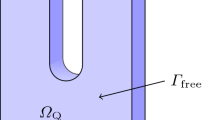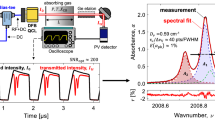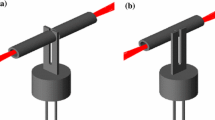Abstract
Trace gas sensors have a wide range of applications including air quality monitoring, industrial process control, and medical diagnosis via breath biomarkers. Quartz-enhanced photoacoustic spectroscopy and resonant optothermoacoustic detection are two techniques with several promising advantages. Both methods use a quartz tuning fork and modulated laser source to detect trace gases. To date, these complementary methods have been modeled independently and have not accounted for the damping of the tuning fork in a principled manner. In this paper, we discuss a coupled system of equations derived by Morse and Ingard for the pressure, temperature, and velocity of a fluid, which accounts for both thermal effects and viscous damping, and which can be used to model both types of trace gas sensors simultaneously. As a first step toward the development of a more realistic model of these trace gas sensors, we derive an analytic solution to a pressure–temperature subsystem of the Morse–Ingard equations in the special case of cylindrical symmetry. We solve for the pressure and temperature in an infinitely long cylindrical fluid domain with a source function given by a constant-width Gaussian beam that is aligned with the axis of the cylinder. In addition, we surround this cylinder with an infinitely long annular solid domain, and we couple the pressure and temperature in the fluid domain to the temperature in the solid. We show that the temperature in the solid near the fluid–solid interface can be at least an order of magnitude larger than that computed using a simpler model in which the temperature in the fluid is governed by the heat equation rather than by the Morse–Ingard equations. In addition, we verify that the temperature solution of the coupled system exhibits a thermal boundary layer. These results strongly suggest that for computational modeling of resonant optothermoacoustic detection sensors, the temperature in the fluid should be computed by solving the Morse–Ingard equations rather than the heat equation.












Similar content being viewed by others
Notes
These formulae were obtained by solving the incompressible linear Navier–Stokes equation for viscous fluid flow around a sphere.
A theorem in the text of Chorin and Marsden [31] states that for a vector field, \(\mathbf {v}\), on a domain \(\varOmega \subset {\mathbb {R}^{3}}\), the Helmholtz decomposition, \(\mathbf v = \mathbf v _\ell + \mathbf v _\mathrm{t}\), is unique, provided that we also assume that \(\mathbf v _\mathrm{t}\) is tangential to the boundary surface, \(\partial \varOmega \).
References
Cordioli J, Martins G, Mareze P, Jordan R (2010) A comparison of models for visco-thermal acoustic problems. In: Proceedings of the Inter-Noise. International Institute of Noise Control Engineering, Osaka
Kampinga R (2010) Viscothermal acoustics using finite elements: analysis tools for engineers. PhD Thesis, University of Twente, Enschede
Gliere A, Rouxel J, Parvitte B, Boutami S, Zeninari V (2013) A coupled model for the simulation of miniaturized and integrated photoacoustic gas detector. Int J Thermophys 34:2119–2135
Joly N, Bruneau M, Bossart R (2006) Coupled equations for particle velocity and temperature variation as the fundamental formulation of linear acoustics in thermo-viscous fluids at rest. Acta Acust United Acust 92:202–209
Lavergne T, Joly N, Durand S (2013) Acoustic thermal boundary condition on thin bodies: application to membranes and fibres. Acta Acust United Acust 99:524–536
Morse P, Ingard K (1986) Theoretical acoustics. Princeton University Press, Princeton
Cao Y, Diebold GJ (1997) Effects of heat conduction and viscosity on photoacoustic waves from droplets. Opt Eng 36(2):417–422
Kosterev A, Bakhirkin Y, Curl R, Tittel F (2002) Quartz-enhanced photoacoustic spectroscopy. Opt Lett 27:1902–1904
Kosterev A, Doty J III (2010) Resonant optothermoacoustic detection: technique for measuring weak optical absorption by gases and micro-objects. Opt Lett 35(21):3571–3573
Petra N, Zweck J, Minkoff S, Kosterev A, Doty J III (2011) Modeling and design optimization of a resonant optothermoacoustic trace gas sensor. SIAM J Appl Math 71(1):309–332
Curl R, Capasso F, Gmachl C, Kosterev A, McManus B, Lewicki R, Pusharsky M, Wysocki G, Tittel F (2010) Quantum cascade lasers in chemical physics. Chem Phys Lett 487:1–18
Lewicki R, Jahjah M, Ma Y, Stefanski P, Tarka J, Razeghi M, Tittel F (2013) Current status of mid-infrared semiconductor laser based sensor technologies for trace gas sensing applications. In: Razeghi R, Esaki L, von Klitzing K (eds) The wonder of nanotechnology: present and future of optoelectronics quantum devices and their applications for environment, health, security, and energy. SPIE Press, Bellingham
Tittel F, Lewicki R, Jahjah M, Foxworth B, Ma Y, Dong L, Griffin R (2014) Mid-infrared laser based gas sensor technologies for environmental monitoring, medical diagnostics, industrial and security applications. In: Pereira MF, Shulika O (eds) Terahertz and mid infrared radiation: detection of explosives and CBRN (using terahertz). Springer, Dordrecht
Bell A (1880) On the production and reproduction of sound by light. Am J Sci 20:305–324
Miklos A, Bozoki Z, Jiang Y, Feher M (1994) Experimental and theoretical investigation of photoacoustic-signal generation by wavelength-modulated diode lasers. Appl Phys B 58:483–492
Patimisco P, Scamarcio G, Tittel F, Spagnolo V (2014) Quartz-enhanced photoacoustic spectroscopy: a review. Sensors (Special Issue “Gas Sensors-2013”) 14:6165–6206
Nye J (2000) Physical properties of crystals. Oxford University Press, New York
Ma Y, Lewicki R, Razeghi M, Tittel F (2013) QEPAS based ppb-level detection of CO and \(\text{ N }_{2}\text{ O }\) using a high power CW DFB-QCL. Opt Express 21(1):1008–1019. doi:10.1364/OE.21.001008
Zheng H, Dong L, Yin X, Liu X, Wu H, Zhang L, Ma W, Yin W, Jia S (2015) Ppb-level QEPAS NO\(_2\) sensor by use of electrical modulation cancellation method with a high power blue LED. Sens Actuators B 208:173–179
Firebaugh S, Sampaolo A, Patimisco P, Spagnolo V, Tittel F. (2015) Modeling the dependence of fork geometry on the performance of quartz enhanced photoacoustic spectroscopic sensors. In: Conference on lasers and electro-optics, ATu1J3. San Jose
Firebaugh S, Terray E, Dong L (2013) Optimization of resonator radial dimensions for quartz enhanced photoacoustic spectroscopy systems. In: Proceedings of SPIE 8600, laser resonators, microresonators, and beam control XV, 86001S
Petra N, Zweck J, Kosterev A, Minkoff S, Thomazy D (2009) Theoretical analysis of a quartz-enhanced photoacoustic spectroscopy sensor. Appl Phys B 94:673–680
Newell W (1968) Miniaturization of tuning forks. Science (New Series) 161(3848):1320–1326
Kokubun K, Hirata M, Murakami H, Toda Y, Ono M (1984) A bending and stretching mode crystal oscillator as a friction vacuum gauge. Vacuum 34:731–735
Landau LD, Lifshitz EM (1959) Fluid mechanics. Addison-Wesley, Reading
Dong L, Kosterev A, Thomazy D, Tittel F (2011) Compact portable QEPAS multi-gas sensor. Proc SPIE 7945:79450R:1–79450R:7
Bossart R, Joly N, Bruneau M (2003) Hybrid numerical and analytical solutions for acoustic boundary problems in thermo-viscous fluids. J Sound Vib 263:69–84
Miklós A, Schäfer S, Hess P (1999) Photoacoustic spectroscopy, theory. In: Lindon J, Tranter G, Holmes J (eds) Encyclopedia of spectroscopy and spectrometry. Academic Press, London, pp 1815–1822
Petra N, Kosterev A, Zweck J, Minkoff S, Doty J III (2010) Numerical and experimental investigation for a resonant optothermoacoustic sensor. In: Conference on lasers and electro-optics. CMJ6, San Jose
Petra N, Zweck J, Minkoff S, Kosterev A, Doty J III (2011) Validation of a model of a resonant optothermoacoustic trace gas sensor. In: Conference on lasers and electro-optics. JTuI115, Baltimore
Chorin AJ, Marsden JE (1979) A mathematical introduction to fluid mechanics. Springer, New York
Olver F, Maximon L (2010) Digital library of mathematical functions, chap 10: Bessel functions. http://www.dlmf.nist.gov/10
Boyce W, DiPrima R (2005) Elementary differential equations, 8th edn. Wiley, New York
Meyer C (2000) Matrix analysis and applied linear algebra. SIAM, Philadelphia
Logg A, Mardal K, Wells G (2012) Automated solution of differential equations by the finite element method. Springer, Berlin
Brennan B, Kirby R, Zweck J, Minkoff S (2013) High-performance python-based simulations of pressure and temperature waves in a trace gas sensor. In: Proceedings of PyHPC 2013: Python for high perfomance and scientific computing
Geuzaine C, Remacle JF (2009) Gmsh: a three-dimensional finite element mesh generator with built-in pre- and post-processing facilities. Int J Numer Methods Eng 79(11):1309–1331
Balay S, Abhyankar S, Adams MF, Brown J, Brune P, Buschelman K, Dalcin L, Eijkhout V, Gropp W, Kaushik D, Knepley M, McInnes L, Rupp K, Smith B, Zampini S, Zhang H (2015) PETSc Webpage. http://www.mcs.anl.gov/petsc
Dong L, Kosterev AA, Thomazy D, Tittel FK (2010) QEPAS spectrophones: design, optimization, and performance. Appl Phys B 100:627–635
Author information
Authors and Affiliations
Corresponding author
Rights and permissions
About this article
Cite this article
Kaderli, J., Zweck, J., Safin, A. et al. An analytic solution to the coupled pressure–temperature equations for modeling of photoacoustic trace gas sensors. J Eng Math 103, 173–193 (2017). https://doi.org/10.1007/s10665-016-9867-5
Received:
Accepted:
Published:
Issue Date:
DOI: https://doi.org/10.1007/s10665-016-9867-5
Keywords
- Mathematical modeling
- Optothermal detection
- Photoacoustic spectroscopy
- Trace gas sensing
- Viscothermal effects




